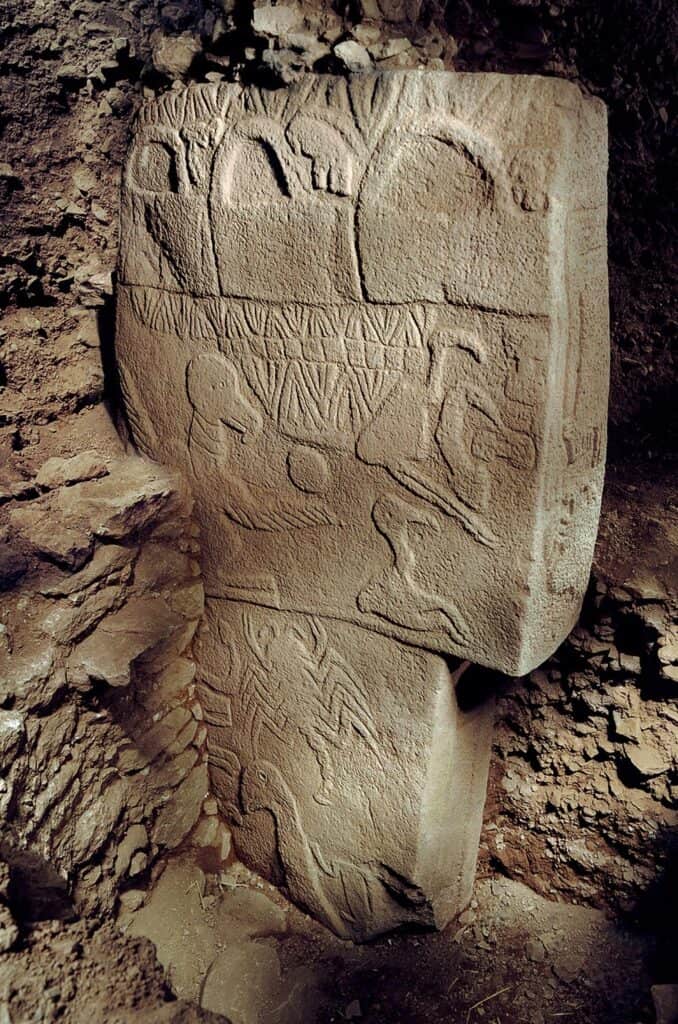Table of Contents


What AI makes of this
The stone in the image you uploaded appears to be from Göbekli Tepe, an ancient archaeological site in southeastern Turkey View. This site dates back to around 9600 BCE and is one of the oldest known monumental structures built by humans. The carvings on the stones at Göbekli Tepe are believed to have symbolic or ritual significance.
The stone you provided shows several carvings, including animals and abstract shapes. Here are some key observations:
- Animals: Many of the stones at Göbekli Tepe are carved with images of animals such as birds, snakes, scorpions, and wild boars. The bird at the bottom of the stone seems to be a common motif at this site and could represent vultures or cranes, which are often found on Göbekli Tepe’s monolithic pillars.
- Geometric Patterns: Above the animals, there are intricate geometric designs, such as triangles or zigzag patterns. These patterns may symbolize abstract ideas or have cultural meanings that we don’t fully understand yet, possibly related to cosmology or spiritual beliefs of the people who built this site.
- Human-like figures: The stones often feature human-like or anthropomorphic shapes in abstract or stylized forms, potentially representing deities, spirits, or ancestors. The pillar in the image shows one such figure.
The meaning of these carvings remains a subject of scholarly debate, but they likely had ritualistic or symbolic significance related to religious practices or ancestor veneration. The entire site of Göbekli Tepe is often associated with early communal activities, such as feasting or worship, rather than domestic living.

The image you uploaded shows a stylized carving that appears to resemble the designs found on the backs of the Moai statues on Easter Island (Rapa Nui) View. The Moai are famous large stone statues made by the Rapa Nui people, and some have intricate carvings on their backs, especially those located at Ahu Nau Nau and Rano Raraku.
Here are some notable features in the carving:
- Anthropomorphic or Mythical Figures: The central portion of the carving seems to depict human or possibly mythological figures, likely linked to Rapa Nui’s birdman (Tangata Manu) cult. This cult was centered around the annual ritual competition where men competed to retrieve the first egg of the sooty tern bird.
- Symmetry of Two Figures: There appear to be two symmetric animals or figures, which could represent the duality often found in Polynesian art, symbolizing balance, fertility, or power.
- Geometric Motifs: A circle or circular motif is seen in the middle, which may represent the sun, a common theme in Rapa Nui carvings, symbolizing life and energy.
- Belt-like Design: The lower part of the carving shows what looks like a belt or a knot, possibly representing social status, ceremonial garments, or another significant symbol related to authority or ritual practice.
These intricate carvings on the backs of the Moai statues might represent Rapa Nui beliefs in ancestor worship, their link to the spiritual world, or ritualistic traditions like the birdman cult, which was crucial in their culture.
The carvings in the two images you provided do have notable similarities in their depiction of anthropomorphic or mythical figures. Here are the main points of comparison:
1. Stylized Human or Animal Forms
- Göbekli Tepe: The first stone shows stylized animal figures, possibly birds or reptiles, along with abstract human-like shapes. The representation is somewhat schematic, emphasizing the ritual or symbolic importance rather than realistic anatomy.
- Easter Island: The second carving also features highly stylized figures, likely mythological or symbolic, such as the birdman figures from Rapa Nui culture. These figures, while anthropomorphic, are not realistic but instead convey spiritual or symbolic meaning.
2. Duality and Symmetry
- Göbekli Tepe: The stone carving includes animals and human-like shapes arranged in a somewhat symmetrical manner, indicating a possible symbolic balance between different forces or ideas.
- Easter Island: The carving shows a clear symmetry, particularly in the paired mythical figures. This symmetry is often a key aspect of ritual and mythological representation, suggesting a balance between opposing forces (e.g., life and death, power and submission).
3. Geometric and Abstract Motifs
- Göbekli Tepe: Above the animals and human-like forms are intricate geometric patterns, such as zigzags and triangles, which seem to have symbolic or cosmological significance.
- Easter Island: The carving also incorporates geometric designs, particularly in the circular motif at the center, which may symbolize the sun or celestial bodies. The combination of these motifs with anthropomorphic figures suggests a fusion of cosmic and human elements, much like Göbekli Tepe.
4. Connection to Rituals and Mythology
- Göbekli Tepe: The carvings are associated with early religious or communal practices, possibly ancestor worship or fertility rituals. The anthropomorphic figures could represent deities, spirits, or ancestors involved in these practices.
- Easter Island: The figures on the Moai’s back are closely related to the birdman cult, which was a crucial part of Rapa Nui’s ritual life. The anthropomorphic figures likely represent spiritual beings or ancestors, much like at Göbekli Tepe.
Conclusion
Both carvings, despite being from vastly different times and places, share a common focus on the symbolic representation of anthropomorphic or mythical figures, with an emphasis on symmetry, geometric patterns, and a connection to ritual and spiritual practices. These similarities suggest that both cultures used art to represent complex cosmologies and beliefs about the divine or the ancestral world.

